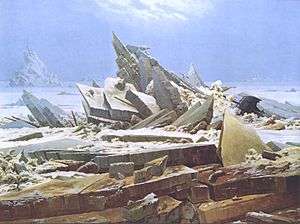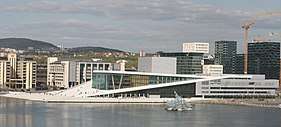The Sea of Ice
The Sea of Ice (German: Das Eismeer), also called The Wreck of Hope (German: Die gescheiterte Hoffnung) is an oil painting of 1823–1824 by the German Romantic artist Caspar David Friedrich.
| The Sea of Ice | |
|---|---|
| German: Das Eismeer | |
 | |
| Artist | Caspar David Friedrich |
| Year | 1823–1824 |
| Medium | Oil on canvas |
| Dimensions | 96.7 cm × 126.9 cm (38 in × 49.9 in) |
| Location | Kunsthalle Hamburg, Hamburg, Germany |
Description
The landscape depicts a shipwreck in the middle of a broken ice-sheet, whose shards have piled up after the impact. The ice has become like a monolithic tomb whose edges jut into the sky.
The stern of the wreck is just visible on the right. As an inscription on it confirms, this is HMS Griper, one of two ships that took part in William Edward Parry's 1819–1820 and 1824 expeditions to the North Pole.
Title
The two titles originally referred to the present work and another older work by Friedrich, now missing. The lost painting was shown in 1822 at the Dresden Academy exhibition under the title A Wrecked Ship off the Coast of Greenland in the Moonlight. Own Invention.[1] The present painting was first shown in 1824 at the Prague Academy exhibition under the title An Idealized Scene of an Arctic Sea, with a Wrecked Ship on the Heaped Masses of Ice.[2]
In Friedrich's estate this work was described as Ice Picture. The Disaster-stricken North Pole Expedition.[3]
History
The collector Johann Gottlob von Quandt commissioned two pictures that were to symbolize the south and the north. Johann Martin von Rohden received the commission to paint Southern Nature in her Abundant and Majestic Splendor,[4] while the commission for Northern Nature in the whole of her Terrifying Beauty[5] fell to Friedrich. However, as Schukowski in a letter dated 1821 reported, Friedrich –
himself does not even know what he will paint; he waits for the moment of inspiration, which (in his own words) occasionally comes in a dream.[6]
Accounts of expeditions to the North Pole were occasionally published during those years which is likely how Friedrich became familiar with William Edward Parry's 1819–1820 expedition to find the Northwest Passage. In the winter of 1820–21, Friedrich made extensive oil studies of ice floes on the river Elbe, near Dresden. These were probably incorporated into The Sea of Ice.
The image created a lasting impression on the French sculptor David d'Angers during his visit to Dresden in 1834, which he described as follows:
Friedrich has a somber spirit. He has understood completely how to represent in landscape the great struggles of nature.[6]
Overall, however, the work was seen as too radical in composition, and went unsold until after Friedrich's death in 1840.[7]
Influence
From the twentieth century the work has proved influential upon the arctic landscapes of Lawren Harris,[8] and it directly influenced Paul Nash's painting Totes Meer.[9] The painting has been hailed by critic Russell Potter as a key instance of the "Arctic Sublime", and an influence on later nineteenth-century polar paintings.[10]
Architect Thom Mayne references The Sea of Ice as a primary influence as to how he approaches the dynamic relationship between architecture, landscape, and nature.[11]
It possibly served as an inspiration for the Sydney Opera House.[12]

The outdoor, free-floating sculpture "She Lies" by Monica Bonvicini is a three-dimensional interpretation of the original Friedrich's painting installed in the Oslo fjord next to the Oslo Opera House.[13] The sculpture opened in May 2010 and has became one of the tourist attractions in the downtown Oslo.[13][14]
Notes
- "Ein gescheitertes Schiff auf Grönlands Küste im Wonne-Mond. Eigene Erfindung"
- "Ideale Szene eines arktischen Meeres, ein gescheitertes Schiff auf den aufgetürmten Eismassen"
- "Eisbild. Die verunglückte Nordpolexpedition "
- "Die südliche Natur in ihrer üppigen und majestätischen Pracht"
- "Natur des Nordens in der ganzen Schönheit ihrer Schrecken"
- Schmied: Caspar David Friedrich
- "Friedrich, Caspar David". Web Gallery of Art. Retrieved 2007-04-23.
- Larisey, Peter: "Light for a Cold Land: Lawren Harris's Life and Work". Dundurn, 1993. 14. ISBN 1-55002-188-5
- Causey, Andrew. Paul Nash. New York : Oxford University Press, 1980
- Potter, Russell A. Arctic Spectacles: The Frozen North in Visual Culture, 1818–1875 (Seattle: University of Washington Press, 2007), pp. 57–59 ISBN 0-295-98679-4
- "Heritage Transformed with Thom Mayne".
- https://www.abc.net.au/news/2013-10-31/larsen-sydney-opera-house/5060118
- "Monica Bonvicini – She Lies in Oslo". www.art-agenda.com. Retrieved 2020-01-20.
- "She Lies (Oslo) - 2020 All You Need to Know BEFORE You Go (with Photos)". TripAdvisor. Retrieved 2020-01-20.
References
- Schmied, Wieland (1992). Caspar David Friedrich. Cologne: DuMont. ISBN 3-8321-7207-6